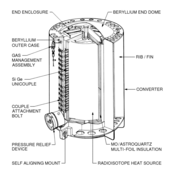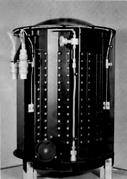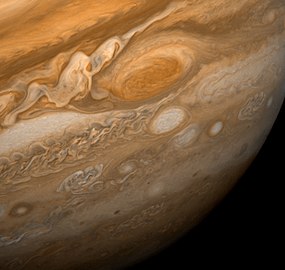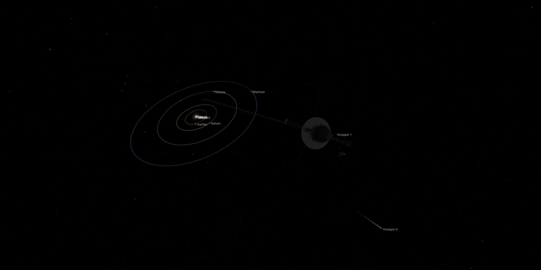
Voyager 1
Voyager 1 is a space probe launched by NASA on September 5, 1977, as part of the Voyager program to study the outer Solar System and the interstellar space beyond the Sun's heliosphere. It was launched 16 days after its twin, Voyager 2. It communicates through the NASA Deep Space Network (DSN) to receive routine commands and to transmit data to Earth. Real-time distance and velocity data are provided by NASA and JPL.[4] At a distance of 163.1 AU (24.4 billion km; 15.2 billion mi) from Earth as of June 2024,[4] it is the most distant human-made object from Earth.[5] The probe made flybys of Jupiter, Saturn, and Saturn's largest moon, Titan. NASA had a choice of either doing a Pluto or Titan flyby; exploration of the moon took priority because it was known to have a substantial atmosphere.[6][7][8] Voyager 1 studied the weather, magnetic fields, and rings of the two gas giants and was the first probe to provide detailed images of their moons.
For other uses, see Voyager 1 (disambiguation).Mission type
Outer planetary, heliosphere, and interstellar medium exploration
1977-084A[1]
10321[1]
- 46 years, 9 months, 18 days
elapsed
- Planetary mission: 3 years, 3 months, 9 days
- Interstellar mission: 43 years, 6 months, 10 days elapsed
Mariner Jupiter-Saturn
Jet Propulsion Laboratory
815 kg (1,797 lb)[2]
721.9 kg (1,592 lb)[3]
470 watts (at launch)
September 5, 1977, 12:56:01 UTC
2036 (planned)
March 5, 1979
349,000 km (217,000 mi)
November 12, 1980
124,000 km (77,000 mi)
November 12, 1980
6,490 km (4,030 mi)
As part of the Voyager program and like its sister craft Voyager 2, the spacecraft's extended mission is to locate and study the regions and boundaries of the outer heliosphere and to begin exploring the interstellar medium. Voyager 1 crossed the heliopause and entered interstellar space on August 25, 2012, making it the first spacecraft to do so.[9][10] Two years later, Voyager 1 began experiencing a third wave of coronal mass ejections from the Sun that continued to at least December 15, 2014, further confirming that the probe is in interstellar space.[11]
In 2017, the Voyager team successfully fired the spacecraft's trajectory correction maneuver (TCM) thrusters for the first time since 1980, enabling the mission to be extended by two to three years.[12] Voyager 1's extended mission is expected to continue to return science data until at least 2025, with a maximum lifespan of until 2030.[13] Its radioisotope thermoelectric generators (RTGs) may supply enough electric power to return engineering data until 2036.[14]
In March 2013, it was announced that Voyager 1 might have become the first spacecraft to enter interstellar space, having detected a marked change in the plasma environment on August 25, 2012. However, until September 12, 2013, it was still an open question as to whether the new region was interstellar space or an unknown region of the Solar System. At that time, the former alternative was officially confirmed.[83][84]
In 2013 Voyager 1 was exiting the Solar System at a speed of about 3.6 AU (330 million mi; 540 million km) per year, while Voyager 2 is going slower, leaving the Solar System at 3.3 AU (310 million mi; 490 million km) per year.[85] Each year, Voyager 1 increases its lead over Voyager 2.
Voyager 1 reached a distance of 135 AU (12.5 billion mi; 20.2 billion km) from the Sun on May 18, 2016.[4] On September 5, 2017, that had increased to about 139.64 AU (12.980 billion mi; 20.890 billion km) from the Sun, or just over 19 light-hours; at that time, Voyager 2 was 115.32 AU (10.720 billion mi; 17.252 billion km) from the Sun.[4]
Its progress can be monitored at NASA's website.[4][86]
On September 12, 2013, NASA officially confirmed that Voyager 1 had reached the interstellar medium in August 2012 as previously observed. The generally accepted date of arrival is August 25, 2012 (approximately 10 days before the 35th anniversary of its launch), the date durable changes in the density of energetic particles were first detected.[74][75][76] By this point, most space scientists had abandoned the hypothesis that a change in magnetic field direction must accompany a crossing of the heliopause;[75] a new model of the heliopause predicted that no such change would be found.[87]
A key finding that persuaded many scientists that the heliopause had been crossed was an indirect measurement of an 80-fold increase in electron density, based on the frequency of plasma oscillations observed beginning on April 9, 2013,[75] triggered by a solar outburst that had occurred in March 2012[72] (electron density is expected to be two orders of magnitude higher outside the heliopause than within).[74] Weaker sets of oscillations measured in October and November 2012[84][88] provided additional data. An indirect measurement was required because Voyager 1's plasma spectrometer had stopped working in 1980.[76] In September 2013, NASA released recordings of audio transductions of these plasma waves, the first to be measured in interstellar space.[89]
While Voyager 1 is commonly spoken of as having left the Solar System simultaneously with having left the heliosphere, the two are not the same. The Solar System is usually defined as the vastly larger region of space populated by bodies that orbit the Sun. The craft is presently less than one-seventh the distance to the aphelion of Sedna, and it has not yet entered the Oort cloud, the source region of long-period comets, regarded by astronomers as the outermost zone of the Solar System.[73][84]
In October 2020, astronomers reported a significant unexpected increase in density in the space beyond the Solar System as detected by the Voyager 1 and Voyager 2 space probes. According to the researchers, this implies that "the density gradient is a large-scale feature of the VLISM (very local interstellar medium) in the general direction of the heliospheric nose".[90][91]
In May 2021, NASA reported on the continuous measurement, for the first time, of the density of material in interstellar space and, as well, the detection of interstellar sounds for the first time.[92]
Communication issues[edit]
In May 2022, NASA reported that Voyager 1 had begun transmitting "mysterious" and "peculiar" telemetric data to the Deep Space Network (DSN). It confirmed that the operational status of the craft remained unchanged, but that the issue stemmed from the Attitude Articulation and Control System (AACS). NASA's Jet Propulsion Laboratory published a statement on May 18, 2022, that the AACS was functional but sending invalid data.[93][94] The problem was eventually traced to the AACS sending its telemetry through a computer that had been non-operational for years, resulting in data corruption. In August 2022, NASA transmitted a command to the AACS to utilize another computer, which resolved the problem. An investigation into what caused the initial switch is underway, though engineers have hypothesized that the AACS had executed a bad command from another onboard computer.[95][96]
Voyager 1 began transmitting unreadable data on November 14, 2023. On December 12, 2023, NASA announced that Voyager 1's flight data system was unable to use its telemetry modulation unit, preventing it from transmitting scientific data.[97] On March 24, 2024, NASA announced that they had made significant progress on interpreting the data being received from the spacecraft.[98] Engineers reported in April 2024 that the failure was likely in a memory bank of the Flight Data Subsystem (FDS), one of the three onboard computer systems, probably from being struck by a high-energy particle or that it simply wore out due to age. The FDS was not communicating properly with the telemetry modulation unit (TMU), which began transmitting a repeating sequence of ones and zeros indicating that the system was in a stuck condition. After a reboot of the FDS, communications remained unusable.[99] The probe still received commands from Earth, and was sending a carrier tone indicating it was still operational. Commands sent to alter the modulation of the tone succeeded, confirming that the probe was still responsive.[100] The Voyager team began developing a workaround,[101][102] and on April 20 communication of health and status was restored by rearranging code away from the defective FDS memory chip, three percent of which was corrupted beyond repair.[37][103] Because the memory is corrupted, the code needed to be relocated, but there were no place for an extra 256 bits; the spacecraft's total memory is only 69.63 kilobytes. To make it work, the engineers deleted unused code, for example the code used to transmit the data from Jupiter, that cannot be used at the current transmission rate. All the data from the "anomaly period" is lost.[104] On May 22, NASA announced that Voyager 1 "resumed returning science data from two of its four instruments", with work towards the others ongoing.[105] On June 13, NASA comfirmed that the probe returns data from all four instruments.[106]












